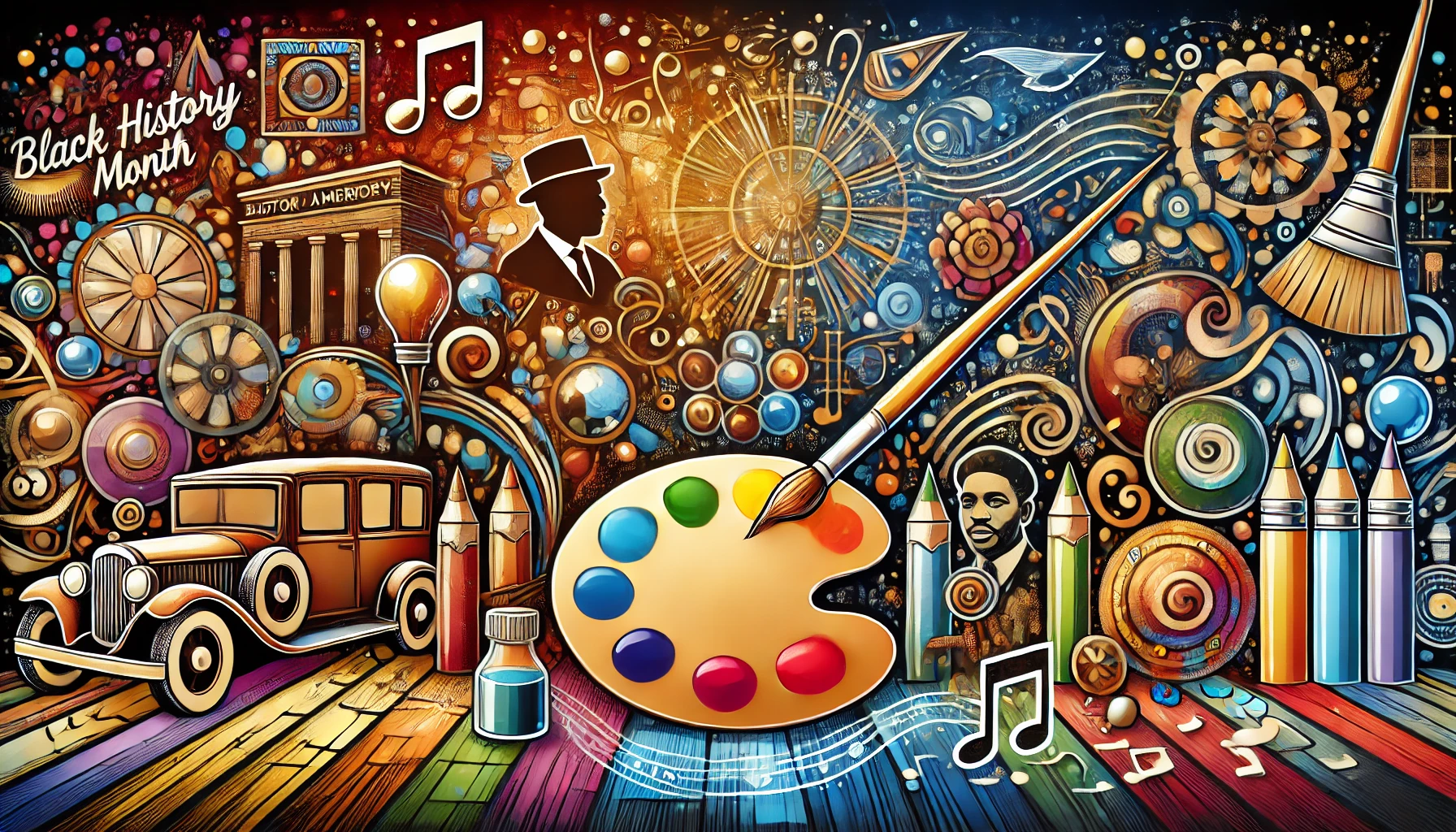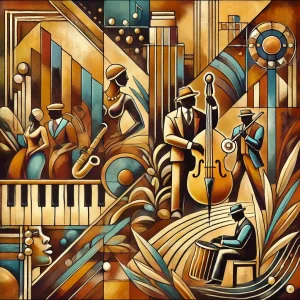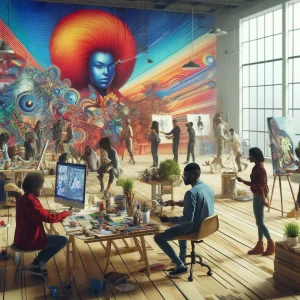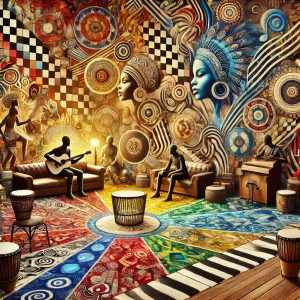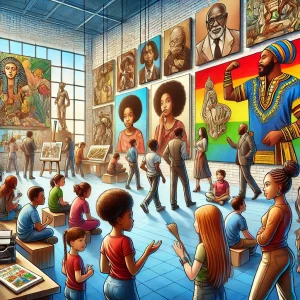Every February, the United States celebrates Black History Month, dedicating time to recognize and honor the profound contributions and the rich history of African Americans. Originating from “Negro History Week,” established by Carter G. Woodson in 1926, Black History Month was officially recognized by President Gerald Ford in 1976. This month serves not only as a reflection on the struggles and achievements of Black Americans but also as an ongoing testament to their central role in the nation’s narrative.
Art, in its myriad forms, has always been a powerful conduit for cultural expression and preservation within the Black community. Whether through the evocative rhythms of jazz, the poignant verses of poetry, or the bold strokes on canvas, art has been instrumental in both documenting and shaping the African American experience. It offers a profound medium through which stories of pain, resilience, triumph, and hope are told and retold, bridging past and present while inspiring future generations.
This article explores how art has been employed to document, confront, and celebrate the African American experience. From the stirring visuals of the Harlem Renaissance to the raw expressive power of contemporary street art, each piece not only reflects personal and collective identities but also acts as a beacon of cultural pride and historical memory. By delving into the ways art influences and is influenced by Black history, we gain deeper insight into the integral role creativity plays in advocacy and self-expression within the Black community.
The Historical Role of Art in Black History
Art has served as a mirror reflecting the societal changes and challenges faced by African Americans throughout history. Key periods such as the Harlem Renaissance and the Civil Rights Movement highlight how art has been a vital tool for social expression and political advocacy.
Harlem Renaissance
The Harlem Renaissance, spanning the 1920s and 1930s, marked a period of vibrant cultural flourish that reshaped African American identity and visibility across the United States. Centered in Harlem, New York, this cultural movement included artists like Aaron Douglas, whose paintings and illustrations captured the essence of African American folklore and aspirations. His iconic style, characterized by silhouetted figures and angular motifs, helped define the visual aesthetic of the era. Another seminal figure was Jacob Lawrence, who documented the great migration of African Americans from the rural South to the urban North in his dynamic and colorful panels, blending narrative storytelling with bold, graphic imagery.
Civil Rights Movement
During the Civil Rights Movement of the 1950s and 1960s, art took on a more overtly political role, serving as a vehicle for protest and demands for equality. Artists like Faith Ringgold challenged societal norms through powerful, narrative quilts that depicted the ongoing struggle for civil rights. Her work, “The Flag is Bleeding,” painted in 1967, portrays the American flag merged with scenes of racial conflict, making a poignant statement about the nation’s turmoil. Similarly, photographer Gordon Parks used his camera to expose the realities of racial segregation and to humanize the everyday lives of African Americans, bringing national attention to issues of social justice.
Expression of Cultural and Political Themes
In both periods, art was not only a reflection of the times but also a challenge to the status quo. By depicting African American life, these artists disrupted the mainstream narratives that often marginalized Black experiences and voices. Their works served as a form of resistance and a declaration of identity, pushing the boundaries of what art could represent and who it was for. Through visual art, literature, music, and performance, African American artists have continually leveraged their creative power to influence public perception and to advocate for political change.
The impact of these artistic movements extends far beyond their initial contexts, continuing to inspire new generations of artists and activists who draw on this rich heritage to explore and express modern-day realities and aspirations.
Contemporary Black Artists and Their Influence
In the modern era, a diverse array of Black artists continues to shape the cultural landscape, utilizing a variety of mediums and styles to express their unique perspectives and experiences. Their work not only enriches the art world but also plays a crucial role in social activism and community dialogue.
Influential Contemporary Black Artists
Kerry James Marshall, known for his large-scale paintings that focus on Black subjects and landscapes, seeks to rectify the absence of African Americans in Western art histories. His works, like “Many Mansions” (1994), are rich in symbolism and detail, depicting scenes of everyday life with profound depth and dignity. Similarly, Kehinde Wiley, who famously painted President Barack Obama’s portrait, subverts traditional portraiture by placing contemporary African American subjects within the framework of classical European art, thereby challenging and redefining norms of beauty and power.
Another influential figure, Kara Walker, utilizes silhouettes to explore the tensions and power dynamics of race, gender, and identity. Her provocative installations, such as “A Subtlety, or the Marvelous Sugar Baby,” comment on historical narratives of slavery and their lingering effects in contemporary society.
Mediums and Styles in Today’s Black Art Scene
Today’s Black art scene is characterized by its technological diversity and interdisciplinary approaches. Artists are increasingly turning to digital art, mixed media, and installation art to communicate their messages. For instance, digital artist LaToya Ruby Frazier uses photography and video to document personal and communal histories, blending narrative depth with stark realism to highlight issues such as environmental justice and healthcare inequality.
Mixed media artist Bisa Butler offers another compelling example. She creates vibrant quilted portraits of Black life, combining traditional quilting techniques with African textiles to produce works that burst with color and pattern, telling stories of familial bonds, cultural heritage, and historical figures.
Contributions to Social Discussions and Movements
Contemporary Black artists have been instrumental in fostering social discussions and movements, notably the Black Lives Matter movement. Their art often serves as a catalyst for social change, offering powerful commentaries on injustice and inequality. For example, Theaster Gates’ community-driven projects in Chicago focus on urban planning and redevelopment through art, transforming spaces and fostering community engagement. His Dorchester Projects not only revitalize neglected buildings but also provide cultural resources and meeting places for local residents.
Similarly, Titus Kaphar’s paintings and sculptures, which physically manipulate traditional narratives to highlight the absence and misrepresentation of African Americans in Western art, provoke viewers to rethink history and acknowledge unspoken truths.
Through their innovative use of media and their commitment to social advocacy, contemporary Black artists continue to influence and inspire, shaping public discourse and bringing vital issues to the forefront of cultural consciousness. Their work ensures that the voices and experiences of the Black community are heard, seen, and valued in the broader tapestry of American life.
Cultural and Social Impact
Black art has profoundly influenced mainstream art and culture, reshaping societal perceptions and contributing to a more inclusive historical narrative. Its impact is evident in the acceptance and celebration of diverse voices within the broader art community, and its integration into public spaces and educational programs has solidified its role in fostering cultural understanding and community pride.
Influence on Mainstream Art and Culture
The influence of Black art on mainstream culture is undeniable, as it introduces new aesthetics, themes, and perspectives into the wider art world. This cross-cultural exchange enriches the artistic landscape and challenges audiences to engage with complex narratives of race, history, and identity. For instance, the bold graphic styles and profound storytelling seen in the works of Jean-Michel Basquiat have become iconic within contemporary art, his legacy evident in the way current artists meld narrative and abstraction. Basquiat’s influence extends beyond galleries, impacting fashion, music, and popular culture, demonstrating the pervasive reach of Black art.
Reception Within Various Communities
The reception of Black art varies across different communities, but it generally prompts reflection, discussion, and a greater appreciation for the diversity of the American experience. In communities of color, it often resonates on a personal level, serving as a source of pride and a means of preserving cultural heritage. In broader contexts, Black art helps to demystify stereotypes and foster empathy, contributing to social cohesion and mutual respect. Exhibitions like those of The Studio Museum in Harlem or the National Museum of African American History and Culture in Washington, D.C., attract a diverse audience, showcasing how Black art is celebrated and valued by a wide array of individuals.
Integration into Public Spaces and Educational Programs
Black art’s integration into public spaces and educational settings is a testament to its societal importance. Murals in cityscapes, such as those created by artists like Kerry James Marshall in Chicago, not only beautify urban environments but also provoke public engagement and dialogue. These artworks make cultural expressions accessible to all, transforming everyday spaces into open-air galleries that invite communal interaction.
Educationally, Black art has become an essential tool for teaching history, culture, and social justice. Schools and universities increasingly incorporate Black artistic contributions into their curricula, recognizing that these works offer powerful insights into the struggles and achievements of African Americans. Art programs that include studies on artists like Faith Ringgold or Augusta Savage help students understand the role of art in social movements and the ongoing fight for equality, inspiring the next generation of artists and activists.
Through these various channels, Black art continues to play a crucial role in shaping cultural identities and promoting social change, making it an indispensable part of the national conversation on race and history. Its presence in both public and private spheres fosters a deeper, more nuanced understanding of Black experiences, past and present.
Challenges and Opportunities
Despite the significant cultural contributions of Black artists, they continue to face systemic challenges that impact their visibility and success in the art world. However, evolving platforms and new technologies are creating unprecedented opportunities for exposure and engagement.
Systemic Challenges Faced by Black Artists
Black artists often grapple with underrepresentation in mainstream art institutions and galleries, which can limit their exposure and access to critical resources for development and sales. This underrepresentation is compounded by economic barriers, as many artists struggle to secure funding and patronage that are readily available to their non-Black counterparts. Additionally, there is a persistent undervaluation of Black art in the art market, which can discourage artists and diminish the perceived worth of their work.
Initiatives and Platforms Supporting Black Artists
In response to these challenges, a number of initiatives and platforms have emerged to support and promote Black artists. For example, The Studio Museum in Harlem has been a pivotal institution in nurturing Black talent, providing artist-in-residence programs that offer space, resources, and exposure to emerging artists. Similarly, online platforms like Black Art Sessions provide virtual galleries where artists can showcase their work to global audiences, bypassing traditional gatekeeping mechanisms in the art world.
Organizations such as the Black Artists Fund have been established to directly address financial disparities by offering grants and funding to Black artists, aiming to empower them and support their creative projects. These initiatives not only help artists sustain their careers but also work towards correcting the racial imbalances in the art industry.
Role of Technology and Social Media
Technology and social media have revolutionized the way artists connect with audiences, and for Black artists, these tools have been particularly transformative. Social media platforms like Instagram and Twitter allow artists to bypass traditional barriers to entry, showcasing their work directly to a global audience without the need for gallery representation. This direct-to-consumer approach not only increases their visibility but also allows for the cultivation of a supportive community of followers and collectors.
Furthermore, digital art and NFTs (Non-Fungible Tokens) have opened new avenues for Black artists to monetize their work and gain recognition in the digital space. These technologies democratize art consumption, allowing artists to retain more control over their work and their earnings.
By leveraging these opportunities, Black artists are finding new ways to overcome traditional barriers and reshape the landscape of the art world, ensuring their voices and visions are heard and appreciated on a much broader scale.
The Role of Art in Education and Community Engagement
Art plays a crucial role in education and community engagement, particularly when it comes to teaching and celebrating Black history. Through creative expression, students and community members gain a deeper understanding of the cultural, social, and historical contexts of African Americans, fostering empathy and a greater appreciation for diversity.
Educational Uses of Art
Schools and educational institutions leverage art to enhance learning about Black history and culture. Artistic works serve as powerful educational tools, offering visual and emotional insights that textbooks alone cannot provide. For example, in many schools, the study of the Harlem Renaissance includes an analysis of artwork by figures like Aaron Douglas and Archibald Motley, whose paintings vividly capture the zeitgeist of the 1920s and 1930s Black cultural explosion. By integrating these artworks into the curriculum, educators can offer students a holistic view of Black history that includes its significant cultural and artistic achievements.
Case Studies of Successful Programs
One notable example of successful community engagement through art is the “Art and Remembrance” program conducted by the Smithsonian’s National Museum of African American History and Culture. This program uses art to facilitate discussions among community members about historical injustices and current social issues, promoting healing and understanding. Another example is the Mural Arts Philadelphia program, which includes several projects that transform public spaces with murals that reflect African American heritage and experiences, engaging local communities in both the creation and appreciation of these works.
Future Potential of Art Programs
The potential for future programs that use art to educate and engage is vast. These programs could be structured to be more interactive, such as through the use of digital art installations that allow participants to contribute to a collective art project using tablets or smartphones. Virtual reality (VR) could also be employed to create immersive experiences that transport users to key historical settings, such as a virtual tour of the National Civil Rights Museum or a reenactment of historical events like the March on Washington.
Furthermore, partnerships between schools, local art institutions, and community centers could be strengthened to ensure a continuous exchange of resources and expertise. These collaborations could help sustain educational initiatives and ensure they are accessible to a broader audience, including underserved communities.
By expanding the use of art in educational and community settings, these programs can continue to play a vital role in promoting an inclusive understanding of history and fostering a diverse and engaged community.
Conclusion
Throughout this exploration of the intersections between Black history, culture, and art, we’ve delved into the profound ways in which art serves as a canvas for expression, education, and social activism. From the vibrant outpouring of creativity during the Harlem Renaissance to the potent visual narratives of today’s digital artists, Black art has continuously played a critical role in documenting, confronting, and celebrating the African American experience.
The Enduring Power of Art
Art’s enduring power lies in its ability to transcend mere aesthetics, acting as a tool for celebration, dialogue, and transformation. It captures the essence of the human experience, offering both a mirror and a window—reflecting realities and providing insights into lives different from our own. As we’ve seen, Black artists have leveraged their talents not only to challenge societal norms and inspire change but also to affirm their identities and histories in a world that often sought to marginalize them.
Engaging with and Supporting Black Artists
As readers and members of a broader community, there is a compelling call to action to engage with and support Black artists and art programs. This can be as simple as visiting exhibitions dedicated to Black art, purchasing works by Black artists, or donating to initiatives that foster the growth of Black artists. Supporting educational programs that incorporate Black art can also have a profound impact, nurturing future generations’ understanding of and appreciation for this rich cultural heritage.
By actively participating in these efforts, we contribute to a more inclusive and diverse cultural landscape where art continues to serve as a cornerstone of community, dialogue, and understanding. Let us move forward with the commitment to recognize and elevate the voices and visions of Black artists, ensuring their integral role in the tapestry of global culture and history.

